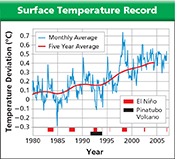Solar Activity
Variations in the sun's radiation have been linked to climate changes on Earth over periods ranging from decades to hundreds of years. The amount of solar energy received by Earth fluctuates over a roughly 11-year cycle that corresponds to changing patterns within the sun. In addition, the intensity of these cycles can vary over hundreds of years. The Little Ice Age, a period of cooling from about 1400 to about 1900, was caused by a decrease in solar output.
Ocean Circulation
Ocean circulation plays a major role in transferring heat around the globe, and thus in controlling regional climates. Water circulates among the oceans in the form of currents. When these currents change over time, they cause climate change. For example, in the Pacific Ocean, water at the equator usually flows westward. But every three to eight years, prevailing winds weaken, and warm equatorial Pacific water moves eastward in an event called El Niño. In the United States, El Niño causes warmer-than-average winters in northern states and wetter-than-average winters in south- eastern states.
Volcanic Activity
Major volcanic eruptions emit huge amounts of ash and aerosols into the atmosphere. Aerosols are tiny solid particles or liquid drops that stay suspended in the air. Volcanic ash and aerosols in the atmosphere can partially reflect incoming solar radiation, resulting in sudden cooling of global climates. For example, eruptions of the Icelandic volcano Laki from 1783 to 1784 were followed by unusually cold winters in Europe and North America.
Data Analysis
Tracking Climate Change
The graph shows how global surface temperatures since 1980 have changed relative to previous years. The blue curve shows the deviation in monthly average surface temperatures. The red curve shows a smoothed five-year average of the monthly data. The year is plotted on the x-axis. Just above the x-axis, two sets of colored bars indicate the durations of two different geologic events: El Niño and the volcanic eruptions of Mount Pinatubo in the Philippines.
Calculating Use the five-year average temperature deviation curve to determine how much Earth's surface temperature increased between 1980 and 2005.
What was the average increase in surface temperature over this period in degrees Celsius per year?
Using Graphs How does El Niño affect the monthly average surface temperature? Is the same effect observed during every El Niño event since 1980? Explain.
Inferring What do you think might have caused monthly average surface temperatures to decline during El Niño events that occurred around 1992 and 1994?






